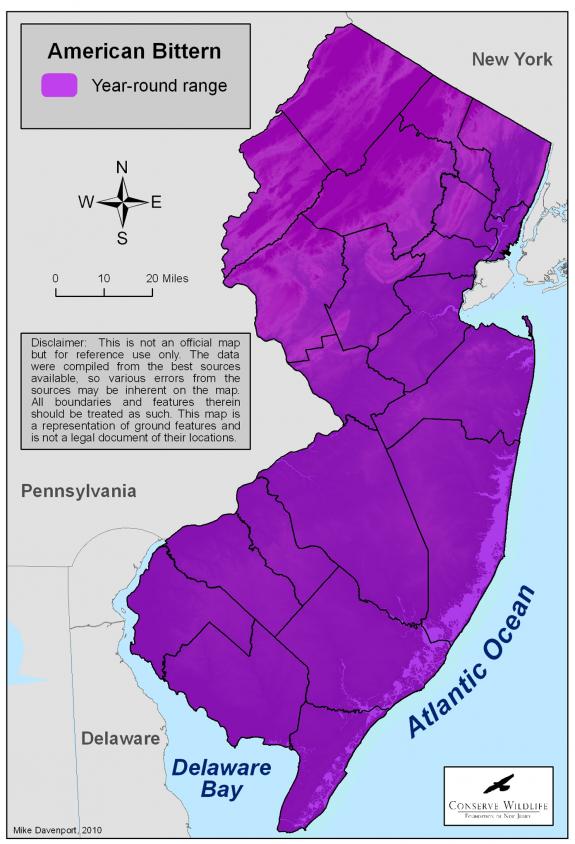Botaurus lentiginosus
Type: bird
Status: endangered
Photo by Howie Williams
Species Guide
American bittern
Botaurus lentiginosus
Species Type: bird
Conservation Status: endangered
Identification
American bitterns live in marshes with dense vegetation. They have thin bodies. This allows them to move easily through thick reeds and grasses. Their camouflaged feathers and shy behavior often allow them to go unnoticed. When frightened, bitterns take on a reed-like position. They point their head skyward and move their body back and forth, imitating a blade of grass blowing gently in the breeze.
The American bittern is a stocky, medium-sized wading bird. The neck and body are buffy-white with brown streaking. Their upperparts are darker brown. Adult bitterns have a black patch on either side of their white throat. The heavy, spear-like bill is yellow with a dark tip. Adult bitterns have yellow eyes, which turn orange during the mating season. The legs of the American bittern are long and yellowish-green. Males and females look alike except that males are slightly larger than females. Young birds resemble adults but do not have the black patches that border the throat. Also, young bitterns have light olive eyes which change to yellow as they mature into adults.
American bitterns look like young black-crowned (Nycticorax nycticorax) and yellow-crowned night-herons (Nyctanassa violacea). However, the bittern can be distinguished by wing pattern, bill shape, feather color, and flight style. While American bitterns have a bi-color wing in flight, young night-herons have solid brown wings. Night-herons also have shorter, fatter bills than bitterns. Bitterns are a more reddish, brown color than young night-herons, which are grayish-brown. Bitterns fly with stiff, laboring wing beats that are quicker than other herons. Bitterns fly low with their legs trailing behind the body.
Bitterns may call during the night. However, vocal activity is greatest at dawn and dusk. They may also call during the day, particularly when skies are overcast. When scared, bitterns often emit a harsh, croaking kok-kok-kok call.

Distribution & Habitat
The breeding range of the American bittern extends from Canada south to the mid-United States, east to the Atlantic Coast, and west to California. During the winter months, bitterns may be found in Mexico and along the Atlantic, Gulf, and Pacific Coasts of the United States.
During the breeding season, American bitterns live in wetlands. Nests are usually found near shallow water in dense vegetation up to 3 feet high. Occasionally, wet fields or grasslands containing tall plants serve as nesting habitats. During migration or in winter, bitterns may be found in wetlands, marshes, and grassy fields.
Diet
American bitterns feed on small mammals, amphibians, reptiles, crustaceans, mollusks, fish, and insects. Hidden by its camouflaged feathers, the bittern stalks prey, standing motionless before striking with its spearlike bill. Bitterns hunt alone. They search for food within marshes or along the shorelines of creeks during the day or at night.
Life Cycle
From late April to May, the booming calls of American bitterns echo throughout their breeding marshes. Males and females may form pairs. But males may also mate with several females. Several females may nest within the territory of one male.
The female bittern builds a nest on the ground or on top of a clump of plants. The nest is found several inches over water or mud. Their nests are usually 6 – 10 inches high and 12 – 16 inches wide. They are constructed of low-growing wetland plants and lined with thin grasses. Nests are highly camouflaged. Hidden pathways lead to and from the nest. To hide the nest’s actual location, bitterns land away from the nest and carefully follow a path leading to it. When leaving from the nest, bitterns walk away from the nest before flying.
During May to mid-June, female bitterns lay three to five eggs. The female bittern incubates the eggs for 24 to 29 days. After they hatch, the female cares for the chicks. She feeds them partially digested food, which she coughs up and shares with her young. The young leave the nest at about two weeks of age and stay in the area for an additional two weeks. However, they remain dependent on their mother for food and shelter.
American bittern fall migration occurs from mid-August to late November and peaks from mid-September to late October. Although most bitterns have departed by late November, some individuals remain and winter in New Jersey. Spring migrants are in New Jersey from early March to mid-May.
Current Threats, Status, and Conservation
Before the early 1900s, the American bittern was a fairly common breeding species in New Jersey. By the 1920s, hunting and wetland destruction caused a decrease in bittern populations. However, bitterns remained within suitable habitat throughout the state during the first half of the century. Since the 1950s, habitat loss has occurred at an alarming rate in New Jersey, destroying wetlands critical to breeding American bitterns. Due to population declines and habitat loss, the breeding population of the American bittern was listed as endangered in New Jersey.
Like many species in New Jersey, protecting American bitterns is closely tied with protecting their wetland habitats. Strong environmental laws to protect wetlands from disturbance and development help to protect wetlands and the American bittern.
Because of the secretive nature and patchy distribution of American bitterns, we still have much to learn about their biology and population status. Research needs to be completed to find additional breeding sites, check existing nesting areas, and determine whether the population might be decreasing or increasing.
Scientific Classification
- Kingdom: Animalia
- Phylum: Chordata
- Class: Aves
- Order: Ciconiiformes
- Family: Ardeidae
- Genus: Botaurus
- Species: B. lentiginosus